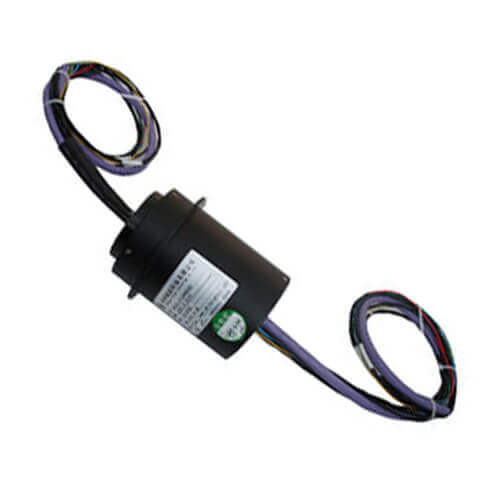As technology progresses, we witness the rise and integration of innovative components designed to optimize system efficiency across various industries – one such element being the Servo Slip Ring. This article serves as a comprehensive guide to unveil the marvel of these devices, elucidating their function, types, applications, benefits, and much more.
Introduction to Servo Slip Rings
In the rapidly evolving world of engineering, there’s often a requirement for a specialized device that can support the uninterrupted transmission of power and data between fixed and rotating parts of a machine. This is where the Servo Slip Ring enters the scene. This innovative component, a form of rotary joint, allows electrical connectivity to be maintained during continuous rotation, making it an essential cog within complex electromechanical systems.
In essence, a servo slip ring is a high-precision device engineered specifically for servomechanisms and automated systems. It offers an uninterrupted electrical connection for the transmission of power and signals from static to rotating components. Servo slip rings are designed to deliver impeccable performance while conserving space and weight, with an added emphasis on superior signal integrity, especially for demanding applications.
The advent of servo slip rings has sparked a significant revolution in modern engineering applications. They have become integral to the functionality and efficiency of numerous kinds of equipment, found across a diverse range of industries. From robotics and automation systems to aerospace applications, servo slip rings deliver crucial operational capacity. For instance, in robotics, they enable the continuous rotation of joints beyond a limited degree, offering the droids enhanced flexibility and functionality.
Moreover, advancements in servo slip ring technology have paved the way for the integration of superior data transmission capabilities, compact sizing, rigorous durability, and improved efficiency by enabling rotational movement without hindrance from wires. All these factors underline the growing dependency on these devices in various sectors, emphasizing the irrefutable significance of servo slip rings in the modern world.
In the following sections, we will delve deeper into how servo slip rings function, shed light on their types, benefits, and limitations, and address user concerns to provide a well-rounded understanding of these pivotal devices.
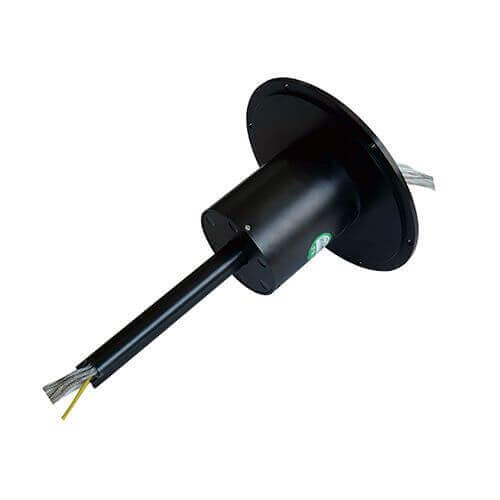
Understanding Servo Slip Rings
Servo slip rings are often considered to be marvels of engineering, as their effective operation permits the interdependent flow of critical power and data between the stationary and rotational components of a system. Developing an appreciation for the principles and technologies underlying their function offers a more profound understanding of their indispensable nature in modern mechanical designs.
How Servo Slip Rings Function
The fundamental functionality of a servo slip ring is rooted in a revolving connection that comprises intuitive brush technology. Electrical contacts called brushes, which typically consist of metal or graphite, are mounted on the stationary part of the assembly. These brushes slide over smooth, circular contact surfaces or rings installed on the rotating component.
As the rotating part moves, the brushes maintain contact with the surface of the contact rings, thereby obtaining a continuous electrical connection. This connection ensures that power and data signals are transmitted seamlessly between the stationary and rotating parts, even during perpetual or intermittent rotation. The innovative brush and ring design not only enables the smooth and reliable flow of signals but also deters the tangling, abrasion, and wear of wires that might otherwise encumber rotation.
The Technology Behind Servo Slip Rings
Servo slip rings employ an intricate blend of diverse engineering disciplines, such as mechanical, electrical, communication, and computer engineering, which work harmoniously in their design and performance. A few notable technological aspects incorporated within servo slip rings include:
- Material Science: Due to their precision-based functionality, servo slip rings necessitate the use of advanced materials, like precious metal alloys, to ensure low noise, low contact resistance, and high reliability during their lifetime.
- Signal Integration: The ability to integrate multiple signal types, like data, video, and even RF signals, within a single servo slip ring unit is a testament to the advancement in slip ring technology. This integration is achieved through purpose-built channels that facilitate a synchronized transmission of diverse signals with minimal interference.
- Miniaturization: The trend of creating space-efficient designs has translated into the demand for compact servo slip rings, especially in applications where the size constraint is crucial. Modern slip rings employ highly integrated designs, providing superior functionality while limiting their footprint.
- Maintenance and Self-lubrication: To extend the lifespan and reduce maintenance requirements, servo slip rings often feature advanced brush materials and self-lubricating contact surfaces. These characteristics minimize the wear and tear during rotation, offering dependable operation even in the most rigorous applications.
In conclusion, the mechanics and technology ingrained in servo slip rings are both precise and multi-disciplinary, facilitating an essential element of functionality in many contemporary engineering applications. The ensuing sections will explore these applications, as well as the types, benefits, and limitations of servo slip rings.
Types of Servo Slip Rings
The versatility and adaptability of servo slip rings have allowed the emergence of various types, each designed to cater to a specific set of needs and applications. The following are some common types of servo slip rings and their distinctive features:
Capsule Slip Rings
Capsule slip rings are compact and lightweight, ideal for applications with limited installation space. They often comprise a single integrated unit containing all the essential components, such as the contact rings and brushes.
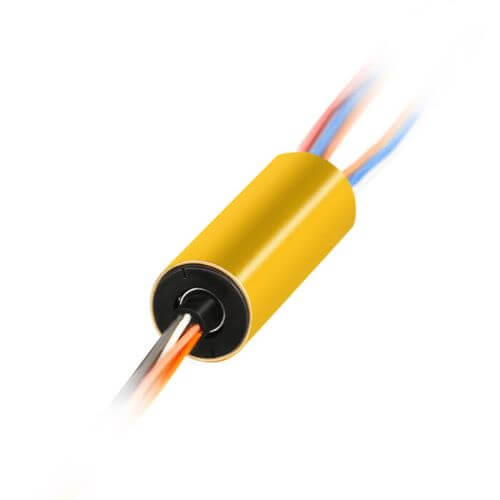
Pancake Slip Rings
Pancake slip rings, distinguished by their flat, disc-like shape, are well-suited for space-constrained applications demanding a lower profile. However, they tend to be more sensitive to debris accumulation compared to traditional cylindrical designs.

Ethernet Slip Rings
Ethernet slip rings, as the name suggests, are specifically engineered to accommodate Ethernet data transmission. They prioritize high-speed communication by minimizing interference and signal degradation, a critical requirement in a modern, connected environment.
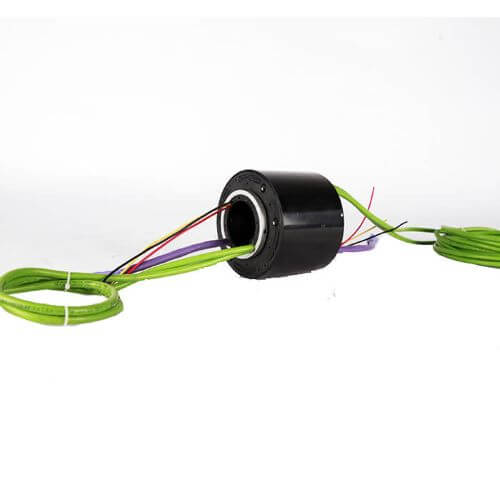
Fiber Optic Slip Rings (FORJs)
Fiber Optic Slip Rings, also known as FORJs (Fiber Optic Rotary Joints), enable the transfer of optical signals in a rotating interface, using advanced fiber optic technology. They deliver unrivaled performance in terms of data transmission capacity and signal integrity, making them ideal for high-speed communication needs.
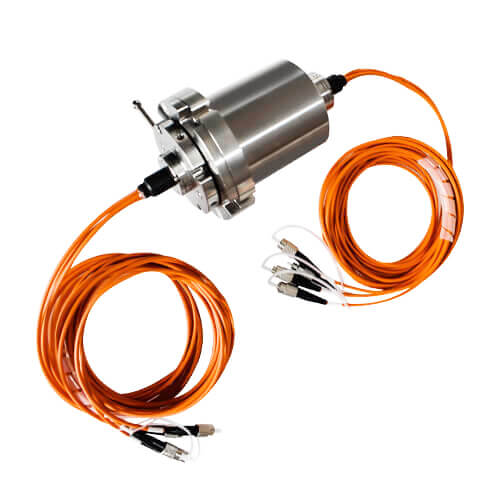
| Slip Ring Type | Key Features | Ideal Applications |
|---|---|---|
| Capsule | Compact, lightweight, single integrated unit | Robotics, small rotary tables, medical devices |
| Pancake | Flat, disc-shaped, low-profile | Compact motors, turntables, radar systems |
| Ethernet | High-speed data transmission, minimized interference, signal degradation | Industrial automation, surveillance systems, robotics |
| Fiber Optic (FORJ) | High data capacity, exceptional signal integrity, low insertion loss | Satellite communication, undersea systems, radar |
This table aims to give an overview of the principal types of servo slip rings and their features, highlighting which applications they are best suited for. It is crucial to delve into the specifics and requirements of your application before choosing a servo slip ring type to ensure that it effectively meets your needs. The forthcoming sections will discuss the industries and applications that benefit from the deployment of servo slip rings and offer guidance on selecting the most appropriate type.
Industries and Applications of Servo Slip Rings
The integral functionality and versatility of servo slip rings have made them a cornerstone in various industries. From orchestrating simple robotic movements to enabling intricate aerospace systems, the applications of these indispensable components are wide-ranging. Let’s explore the industries and applications where servo slip rings often feature prominently.
Industries Relying Heavily on Servo Slip Rings
Several business sectors recognize the impact of servo slip rings on their operational efficiency and effectiveness. Here are some that heavily rely on these components:
- Robotics and Automation: Servo slip rings are key to achieving 360-degree articulation in robotic arms and automated machinery, eliminating cable entanglement issues and allowing for smooth, continuous rotation.
- Aerospace & Defense: In systems like radars, satellite communication, and other guided systems, servo slip rings play a critical role in the transmission of power and data. The high precision, low friction, and minimal maintenance requirements make them particularly suited to the rigors of these demanding environments.
- Medical Industry: Devices such as CT scanners, X-ray machines, and MRI machines rely on servo slip rings to transfer data and power while maintaining the necessary rotation of internal components.
- Energy Generation: In wind turbines, servo slip rings transmit electrical power and signals between the stationary and rotating sections, facilitating the continual generation and distribution of energy.
- Industrial Engineering: In manufacturing and processing industries, servo slip rings are widely used in rotary tables, production lines, and heavy machinery to enable uninterrupted operation.

Real-World Applications of Servo Slip Rings
Delving deeper into the realm of practical applications, the following scenarios illustrate the widespread usage of servo slip rings:
- Robotic Arms in Manufacturing: Various assembly and production lines employ robotic arms to handle their operations. The 360-degree rotational ability of these arms is made possible by the use of servo slip rings, enabling increased production flexibility and efficiency.
- Satellite Communication Systems: Servo slip rings are essential in ensuring seamless data transmission from rotating antennas to fixed base stations, allowing perpetual and unhindered communication.
- Medical Imaging Devices: In a CT scanner, servo slip rings manage the power and signal transmission between the rotating gantry and stationary parts of the machine, enabling the flawless generation of cross-sectional images of the human body.
- Wind Turbines: Servo slip rings transmit electrical power produced by the rotating blades of the wind turbine to the fixed base, facilitating the continual generation and distribution of renewable energy.
By providing an unbroken electrical connection, servo slip rings have a wide range of applications across various industries and have indeed become a linchpin in modern mechanical systems. As our reliance on complex electromechanical systems continues to grow, so too will our dependence on the simple yet essential function delivered by servo slip rings.
Benefits and Limitations of Servo Slip Rings
Servo slip rings have proven to be essential in many applications, owing to their ability to provide uninterrupted power and data transmission between stationary and rotating components. However, like any piece of technology, they are not devoid of potential shortcomings. The following sections delve into the main advantages and potential limitations associated with servo slip rings.
Benefits of Servo Slip Rings
The paramount utility of servo slip rings across multiple industries can be attributed to their numerous benefits, including:
- Continuous Transmission: Arguably the greatest benefit of servo slip rings is their ability to provide uninterrupted power and signal transmission amid persistent or intermittent rotation. This facilitates the seamless operation of electromechanical systems that need to rotate while transferring data or power.
- Minimized Wear and Tear: The inherent design of slip rings helps minimize the wear and tear of connecting wires and cables, thereby extending system longevity and overall operational efficiency.
- Integration of Multiple Signals: Modern servo slip rings can handle the transmission of various types of signals, such as power, data, video, and even RF signals, all within the same unit. This results in more direct and efficient communication channels and significantly reduces interference.
- Compact Design: Especially in applications where space is a constraint, the compact and flexible designs of servo slip rings come to the rescue. They ensure a minimal footprint while still delivering excellent functionality.
Limitations of Servo Slip Rings
Despite the various benefits offered by servo slip rings, they come with certain limitations that should be considered:
- Maintenance Requirements: Certain slip ring types may require occasional maintenance due to gradual wear on brushes and contact surfaces. However, advancements in brush materials and self-lubricating designs are countering this drawback.
- Susceptibility to Environmental Conditions: Servo slip rings can be sensitive to harsh environmental conditions, including extreme temperatures, dust, and corrosive atmospheres. Proper encapsulation and protection must be considered depending on the application.
- Limited Data Rates: While servo slip rings effectively transmit data, their data rates might not match those achievable with direct cable connections, particularly over longer distances. This limitation is less of an issue with Fiber Optic Slip Rings, which can handle higher data rates.
In summary, the benefits of servo slip rings, such as continuous transmission, minimal wear and tear, signal integration, and their compact design, explain their ubiquitous presence in various applications. However, it’s essential to consider potential limitations like maintenance requirements, susceptibility to environmental conditions, and limited data rates while choosing these components for your applications. Understanding these factors enables users to make an informed decision about the suitability of servo slip rings for their specific purpose.
Key Considerations When Choosing a Servo Slip Ring
Selecting the right servo slip ring for your application can be a crucial yet challenging task. A host of factors need to be considered to ensure a perfect fit for your specific requirements. Let’s take a look at some of the key elements you should consider when choosing a servo slip ring.
Size and Weight
The dimensions and weight of the servo slip ring significantly influence its compatibility with your setup. Smaller, lighter slip rings, such as capsule slip rings, are often useful in applications with limited space or weight constraints, such as robotics or compact electromechanical assemblies. However, you should not compromise on the performance capabilities needed for your application when considering size and weight.
Current and Voltage Requirements
The electrical specification of the slip ring should match your system’s current and voltage requirements. Misjudging these parameters could lead to poor performance, system instability, or even damage. Make sure to check the operating voltage, current per circuit, and insulation resistance during selection.
Signal Compatibility
Modern servo slip rings can transmit a mix of power, data, and signal types. It’s important to ensure that the slip ring you choose is compatible with the specific signals you need to transfer. This could range from basic electricity and low-frequency signals to complex data transfer and high-frequency signals.
Environmental Conditions
Your system’s operating environment should also dictate your choice of servo slip ring. Factors such as temperature extremes, moisture levels, dust, and corrosive conditions could significantly impact the slip ring’s functionality. Some slip rings are specifically designed to withstand harsh conditions, so it’s important to choose one that aligns with your environment.
Cost and Maintenance
Cost plays an integral part in any decision-making process. Make sure to weigh the initial purchase price against anticipated maintenance costs and the expected lifespan of the unit. Cheaper models might be more cost-effective upfront but could require more frequent maintenance or replacement, leading to higher costs in the long run.
Manufacturer’s Reputation
Lastly, consider the reputation and reliability of the manufacturer. Established manufacturers usually provide better post-sale services, warranties, and technical support. It’s always prudent to choose a servo slip ring from a reputable source to ensure quality, reliability, and proper after-sales support.
It’s important to remember that no single servo slip ring type is universally the best. The optimal choice will always depend on your specific requirements and constraints. By giving due consideration to the factors listed above, you’ll be better equipped to make an informed decision and choose a servo slip ring that best fits your application needs.
What Users Are Mostly Concerned About Servo Slip Rings
While servo slip rings are undeniably useful within various applications, users often express certain concerns regarding their use. These concerns typically revolve around the component’s durability, lifespan, maintenance needs, price, and functionality under different conditions. Understanding and addressing these concerns can lead to improved user confidence and increased adoption of this technology.
Common Concerns
The concerns users often share concerning servo slip rings include:
- Durability and Lifespan: Some users worry about the durability of the servo slip ring, especially in challenging operational environments. The lifespan of the slip ring is directly related to its durability; a robustly constructed slip ring can significantly reduce operational downtime and replacement costs.
- Maintenance Needs: Regular maintenance, although beneficial for the slip ring’s performance, can be troublesome and sometimes expensive for users. The necessity of frequent maintenance is a commonplace concern among users.
- Price: The cost of the servo slip rings can be a major factor causing apprehension among users, particularly for high-end, durable models or those designed for specific, challenging conditions.
- Functionality Under Different Conditions: Users often have concerns about how well the slip rings can function under various conditions, such as extreme temperatures, challenging weather, dust, etc.
Addressing the Concerns
- Durability and Lifespan: To address durability and lifespan concerns, manufacturers often provide detailed specifications, including the expected lifespan under normal use and operational conditions. Manufacturers are also continually improving their designs and materials to enhance the durability and longevity of their products.
- Maintenance Needs: The advancement in slip ring technology has led to self-lubricating designs and the use of robust materials to minimize maintenance needs. It’s always recommended to discuss the maintenance requirements with the manufacturer before purchase.
- Price: The initial investment in a robust and high-quality slip ring can be substantial. However, this is often offset by extended lifespan and reduced maintenance costs over time. An open discussion on your needs, budget, and expectations with the manufacturer can help achieve the best compromise between cost and functionality.
- Functionality Under Different Conditions: Manufacturers typically provide comprehensive information about the operational range and limitations of the slip ring, allowing users to make an informed decision based on their specific needs and environmental conditions. Specialized slip rings designed for harsh environments are also available to cater to highly specific needs.
In conclusion, while users’ concerns regarding servo slip rings are valid, manufacturers and suppliers are continually striving to address these concerns through technological advancements, transparent communication, comprehensive product specifications, and excellent post-purchase support. As a user, gaining a thorough understanding of these factors can help allay common concerns and result in a more confident and informed purchasing decision.
Servo Slip Rings Case Studies or Real-World Application Examples
Servo slip rings have played a pivotal role in the successful implementation of various applications across multiple industries. In this section, we’ll explore detailed examples and case studies of real-world applications that have significantly benefited from incorporating servo slip rings.
Wind Turbine Pitch Control
In the renewable energy sector, servo slip rings play a critical role in wind turbines. They are employed inside the hub, connecting the fixed tower to the rotating blades. Through the continuous transmission of power and data, servo slip rings enable seamless pitch control.
This pitch control allows wind turbines to adapt to fluctuating wind conditions, ensuring optimal power generation and preventing damage due to excessively high wind speeds. By contributing to the stability and efficiency of wind turbines, servo slip rings have delivered substantial benefits to clean energy production.
Robotics
In the rapidly evolving robotics industry, precise and reliable data and power transmission is indispensable. Servo slip rings have been instrumental in achieving uninterrupted power and signal transfer in robotic joints.
Their compact designs make them ideal for integration into robotic systems, where space is often limited. The continuous rotation facilitated by servo slip rings enables smooth, efficient functioning in applications such as robotic arms, automated manufacturing equipment, and robotic medical equipment, resulting in increased productivity and improved precision.
Defense and Aerospace Systems
Servo slip rings have been proven crucial in surveillance and communication systems within the defense and aerospace sectors. They have been successfully used in radar systems for continuous rotation of antennas, ensuring accurate and reliable data transmission without compromising signal integrity.
Moreover, servo slip rings have been employed in drones and other unmanned aerial vehicles (UAVs) for power and data transfer between rotating parts such as gimbals and cameras. This has enabled smooth and uninterrupted operation in mission-critical scenarios, ultimately enhancing situational awareness and response capabilities.
Medical Imaging Equipment
Medical imaging equipment, particularly Computerized Tomography (CT) scanners, rely significantly on servo slip rings for effective functioning. The continuous rotation of the X-ray tube and detector assembly around the patient demands uninterrupted power and data transfer, which only servo slip rings can provide.
Apart from facilitating seamless operation, the precision and reliability of servo slip rings contribute to the accuracy of imaging data, which is crucial for diagnosis and treatment planning. Thus, the integration of servo slip rings in medical imaging equipment has considerably advanced diagnostic capabilities in the healthcare industry.
These case studies highlight the vital role that servo slip rings have played in multiple applications, from clean energy production and robotics to aerospace systems and medical imaging. By enabling continuous transmission of power and data in complex, rotating systems, servo slip rings have continually proven their worth across a wide range of industries.
Conclusion
In conclusion, Servo Slip Rings are not just components; they are an amalgamation of innovation and functionality. From improving efficiency to reducing costs, their benefits are far-reaching, and with the right knowledge, their implementation can be seamless and rewarding. As technology evolves, these dynamic devices will undoubtedly continue to enable advancements in myriad applications.
See What We Can Do

